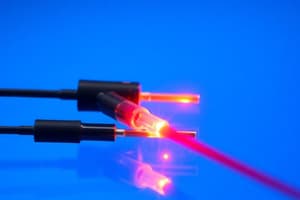Podcast
Questions and Answers
How are ions formed during electrolysis?
How are ions formed during electrolysis?
- By sharing electrons with electrodes
- By absorbing light energy during the process
- By gaining protons from the electrolyte
- By splitting the electrolyte into positively and negatively charged particles (correct)
What is the main purpose of electrolysis?
What is the main purpose of electrolysis?
- To generate electricity
- To analyze the behavior of neutrons in solutions
- To drive chemical reactions using an electric current (correct)
- To study the relationship between current and voltage
Which industry uses electrolysis for the extraction of metals from their compounds?
Which industry uses electrolysis for the extraction of metals from their compounds?
- Pharmaceuticals
- Construction
- Textiles
- Metallurgy (correct)
What is electrode potential also known as?
What is electrode potential also known as?
In an electrochemical cell, where does the reduction process typically occur?
In an electrochemical cell, where does the reduction process typically occur?
What drives the overall redox reaction in an electrochemical cell?
What drives the overall redox reaction in an electrochemical cell?
What does a positive electrode potential indicate?
What does a positive electrode potential indicate?
In the Nernst equation, what does 'n' represent?
In the Nernst equation, what does 'n' represent?
How does the Nernst equation illustrate the relationship between electrode potential and reaction quotient?
How does the Nernst equation illustrate the relationship between electrode potential and reaction quotient?
What information can electrode potentials provide about redox reactions?
What information can electrode potentials provide about redox reactions?
What is a fundamental application of predicting the direction of spontaneous redox reactions?
What is a fundamental application of predicting the direction of spontaneous redox reactions?
How do electrode potentials contribute to the development of electrocatalysts?
How do electrode potentials contribute to the development of electrocatalysts?
Flashcards are hidden until you start studying
Study Notes
Exploring Electrochemistry: Electrolysis and Electrode Potentials
Electrochemistry, a field that combines chemistry and the study of electricity, revolves around the relationship between chemical reactions and electrical phenomena. Here, we'll delve into the fascinating subtopics of electrolysis and electrode potentials, shedding light on their significance and applications.
Electrolysis
Electrolysis, a process that uses electric current to drive chemical reactions, has a wide range of practical applications. In its simplest form, electrolysis involves passing an electric current through an ionic solution, called an electrolyte, which splits it into positively and negatively charged particles—ions. These ions migrate towards the oppositely charged electrodes, eventually leading to the formation of new compounds at the electrodes.
Electrolysis is applied in various industries, including metallurgy (extraction of metals from their compounds), water electrolysis (generation of hydrogen gas for clean energy), and electroplating (deposition of thin films onto various substrates).
Electrode Potentials
Electrode potential, also referred to as reduction potential, is the tendency of a substance to gain electrons. In an electrochemical cell, the difference in electrode potentials between a reducing (cathode) and an oxidizing (anode) electrode drives the overall redox reaction.
Electrode potentials are usually measured relative to a standard hydrogen electrode (SHE), which is assigned a value of 0 V by convention. The electrode potential of a substance is positive when it is more difficult for the substance to gain electrons, while a negative value indicates that it is more favorable.
The Nernst equation, developed by Walther Nernst, illustrates the relationship between electrode potential and reaction quotient:
[E = E° - \frac{RT}{nF} \ln Q]
Where:
- (E) is the electrode potential at non-standard conditions
- (E°) is the standard electrode potential
- (R) is the gas constant (8.314 J/mol·K)
- (T) is the temperature in Kelvin (298 K is commonly used)
- (n) is the number of electrons transferred in the redox reaction
- (F) is the Faraday constant (96,485 C/mol)
- (Q) is the reaction quotient
The Nernst equation shows the influence of temperature, concentration, and the number of electrons transferred on the electrode potential.
Applications of Electrode Potentials
Electrode potentials provide valuable information about the spontaneity and reversibility of redox reactions, as well as the energy changes that occur during these processes. The Nernst equation can be used to predict the direction of spontaneous redox reactions, which is fundamental in designing electrochemical devices and understanding the behavior of redox systems.
Additionally, electrode potentials help us understand corrosion mechanisms and develop strategies to prevent or mitigate corrosion. Moreover, they play a crucial role in the development of electrocatalysts, materials that can enhance the reaction rates of redox reactions in electrochemical devices like fuel cells and batteries, thus improving their performance and efficiency.
Conclusion
Electrolysis and electrode potentials are two fundamental concepts in electrochemistry that have numerous applications across various fields. With its potential to generate clean energy, extract valuable resources, and develop novel materials, electrochemistry continues to be a vibrant and dynamic area of research and development.
Studying That Suits You
Use AI to generate personalized quizzes and flashcards to suit your learning preferences.




